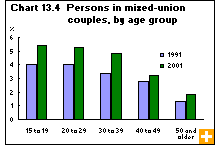Common menu bar links
More mixed couples
Archived Content
Information identified as archived is provided for reference, research or recordkeeping purposes. It is not subject to the Government of Canada Web Standards and has not been altered or updated since it was archived. Please contact us to request a format other than those available.
Marriages and common-law unions involving spouses from different population groups increased in the 1990s. In 2001, of the 14.1 million people living in a marriage or common-law union, 452,000 individuals were in a couple with a visible minority spouse and a non-visible minority spouse, or in a couple with spouses from two different visible minority groups. In 2001, such mixed unions represented 3% of individuals in couples, slightly higher than in 1991.
Japanese-Canadians are the most likely visible minority to marry or live common-law with a non-Japanese person. Next most likely are people of Latin American origin and black people. Among the least likely to marry outside their group are South Asians and Chinese.
Mixed unions account for 7% of all married or common-law couples in Vancouver, 6% in Toronto and 3% in Montréal. However, among people aged 20 to 29, the proportions are almost double: 13% in Vancouver, 11% in Toronto and 6% in Montréal.
Mixed couples are younger—5% of couples aged 20 to 29 versus 1% of couples aged 65 and over in 2001—and are more likely to be foreign-born and to live in a large city. They tend to be better educated than couples in the general population. For example, 6% of people with a university degree are in a mixed union, versus 2% of people with high school or less.
Mixed union couples are more likely to have children. In the general population in 2001, 57% of all couples had children, compared with 59% of couples with a visible minority spouse and a non-visible minority spouse, and 69% of couples with spouses from two different visible minorities.



